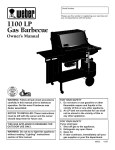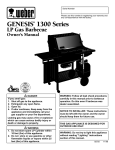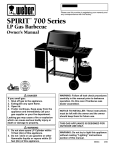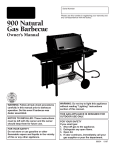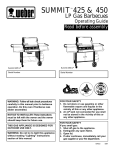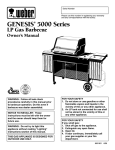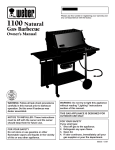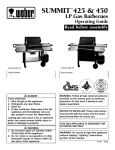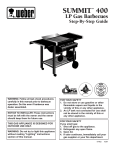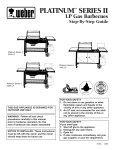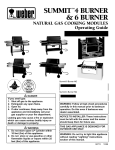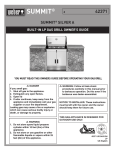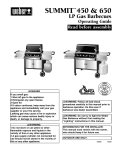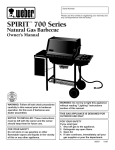Download Weber FT 600 Owner's Manual
Transcript
Serial Number Please use this number in registering your warranty and any correspondence with the factory. FT 600 LP Gas Barbecue Owners’ Manual E F ® National PROPANEGAS Association WARNING: Follow all leak check procedures carefully in this manual prior to barbecue operation. Do this even if barbecue was dealer assembled. NOTICE TO INSTALLER: These instructions must be left with the owner and the owner should keep them for future use. THIS GAS APPLIANCE IS DESIGNED FOR OUTDOOR USE ONLY. WARNING: Do not try to light this appliance without reading "Lighting" instructions section of this manual. FOR YOUR SAFETY 1. Do not store or use gasoline or other flammable vapors and liquids in the vicinity of this or any other appliance. 2. An LP tank not connected for use shall not be stored in the vicinity of this or any other appliance. FOR YOUR SAFETY If you smell gas: 1. Shut off gas to the appliance. 2. Extinguish any open flame. 3. If odor continues, immediately call your gas supplier or your fire department. 96619 4/96 DANGER Failure to follow the Dangers, Warnings and Cautions contained in this Owner’s Manual may result in serious bodily injury or death, or in a fire or an explosion causing damage to property. WARNINGS Do not store a spare or disconnected LP tank under or near this barbecue. Improper assembly may be dangerous. Please carefully follow the assembly instructions in this manual. After a period of storage, and/or nonuse, the Weber Gas Barbecue should be checked for gas leaks and burner obstructions before using. See instructions in this manual for correct procedures. Do not operate the Weber Gas Barbecue if there is a gas leak present. Do not use a flame to check for gas leaks. Combustible materials should never be within 24 inches of the top, bottom, back or sides of your Weber Gas Barbecue. Do not put a barbecue cover or anything flammable on or in the storage area under the barbecue. Your Weber Gas Barbecue should never be used by children. You should exercise reasonable care when operating your Weber Gas Barbecue. It will be hot during cooking or cleaning, and should never be left unattended. If the burners should go out during cooking, turn off all gas valves. Leave sliding covers open and wait five minutes before attempting to relight the gas flame, while observing the “Lighting” instructions. Do not use charcoal or lava rock in your Weber Gas Barbecue. Never lean over open grill or place hands or fingers on the front edge of the cooking box. Should a grease fire occur, turn off all burners until fire is out. Do not enlarge valve orifices or burner ports when cleaning the valves or burners. The Weber Gas Barbecue should be thoroughly cleaned on a regular basis. LP gas is not natural gas. The conversion or attempted use of natural gas in an LP unit or LP gas in a natural gas unit is dangerous and will void your warranty. Do not attempt to disconnect any gas fitting while your barbecue is in operation. Use heat-resistant barbecue mitts or gloves when operating barbecue. LP GAS UNITS ONLY: Use the regulator that is supplied with your Weber Gas Barbecue. Do not attempt to disconnect the gas regulator or any gas fitting while your barbecue is in operation. A dented or rusty LP tank may be hazardous and should be checked by your liquid propane supplier. Do not use an LP tank with a damaged valve. Although your LP tank may appear to be empty, gas may still be present, and the tank should be transported and stored accordingly. If you see, smell or hear the hiss of escaping gas from the LP tank: 1. Get away from LP tank. 2. Do not attempt to correct the problem yourself. 3. Call your fire department. 2 WARRANTY Weber-Stephen Products Co. (Weber) hereby warrants to the ORIGINAL PURCHASER of this Weber Gas Barbecue that it will be free of defects in material and workmanship from the date of purchase as follows: Aluminum Castings, 10 years, Stainless Steel Flavorizer Bars, 5 years, Cooking Grill, 3 years, Cast Iron Griddle, 1 year, All Remaining Parts, 5 years, when assembled and operated in accordance with the printed instructions accompanying it. Weber may require reasonable proof of your date of purchase. THEREFORE, YOU SHOULD RETAIN YOUR SALES SLIP OR INVOICE. This Limited Warranty shall be limited to the repair or replacement of parts which prove defective under normal use and service and which on examination shall indicate, to Weber's satisfaction, they are defective. Before returning any parts, contact WeberStephen Products Co. Customer Service Center. If Weber confirms the defect and approves the claim, Weber will elect to replace such parts without charge. If you are required to return defective parts, transportation charges must be prepaid. Weber will return parts to the purchaser, freight or postage prepaid. This Limited Warranty does not cover any failures or operating difficulties due to accident, abuse, misuse, alteration, misapplication, vandalism, improper installation or improper maintenance or service, or failure to perform normal and routine maintenance, including but not limited to damage caused by insects within the burner tubes, as set out in this owner's manual. Deterioration or damage due to severe weather conditions such as hail, hurricanes, earthquakes or tornadoes, discoloration due to exposure to chemicals either directly or in the atmosphere, is not covered by this Limited Warranty. There are no other express warrants except as set forth herein and any applicable implied warranties of merchantability and fitness are limited in duration to the period of coverage of this express written Limited Warranty. Some states do not allow limitation on how long an implied warranty lasts, so this limitation may not apply to you. Weber is not liable for any special, indirect or consequential damages. Some states do not allow the exclusion or limitation of incidental or consequential damages, so this limitation or exclusion may not apply to you. Weber does not authorize any person or company to assume for it any other obligation or liability in connection with the sale, installation, use, removal, return, or replacement of its equipment; and no such representations are binding on Weber. This Warranty applies only to products sold at retail. WEBER-STEPHEN PRODUCTS CO. Customer Service Center 250 South Hicks Road Palatine, IL 60067-6241 (847) 705-8660 (800) 446-1071 LP Tank The LP tank manufacturer is responsible for the materials, workmanship and performance of the tank. If the tank has a defect, malfunctions, or you have a question regarding the tank, call the tank manufacturer's customer service center. The phone number is on the warning decal which is permanently attached to the tank. If the tank manufacturer has not resolved the issue to your satisfaction, then call Weber-Stephen Products Co., Customer Service Center. 3 PATENTS AND TRADEMARKS © 1996 Weber-Stephen Products Co. Weber, , Flavorizer and Crossover are registered U.S. trademarks; Gas Catcher is a trademark of Weber-Stephen Products Co., 200 East Daniels Road, Palatine, IL 60067-6266, U.S.A. Weber is also a registered trademark (Reg. TM., Marca Registrada, Marque Desposee, Schutzmarke) in Canada, Germany, France, Italy, Spain, Japan, Switzerland, Austria, Norway, Denmark, Greece, Benelux, South Africa, Ireland, United Kingdom, Australia, New Zealand and Korea. This product is covered by: U.S. Patent Nos. 4,677,964; 4,727,853; 4,829,978; 4,860,724 and 4,941,817; Australia Patent No. 598,709 and E83630. Printed in the U.S.A. 4 Contents WARNINGS ..................................................................2 Warranty & Patents .................................................. 3-4 General Instructions .................................................... 6 Assembly................................................................ 7-29 Operating Instructions Lighting .........................................................30-31 Cooking.........................................................32-33 Storage and/or Nonuse..................................... 33 Cleaning............................................................ 33 Gas supply tank Information................................................... 34-36 Troubleshooting & Maintenance Annual Maintenance.................................... 36-37 General Maintenance .................................. 38-41 Troubleshooting ................................................ 42 Parts Listing ......................................................... 44-45 c b a d b e a i h g f FEATURES: a) Convenient work surfaces and racks. f) Fuel scale indicates gas supply. b) Crossover Ignition System with Gas Catcher Ignition Chamber. g) Catch pan catches excess grease. c) Splash guards reduce grease spatters. i) h) Separate burners for temperature control. d) Cooking grill for searing and grilling foods. e) Cast Iron Griddle for frying foods. 5 Locking casters for additional portability. General Instructions Storage The Weber Gas Barbecue is a portable outdoor cooking appliance. With your Weber Gas Barbecue you can grill and barbecue with results that are difficult to duplicate with indoor kitchen appliances. The Weber Gas Barbecue is portable so you can easily change its location in your yard or on your patio. Portability means you can take your Weber Gas Barbecue with you if you move. ■ The gas must be turned OFF at the LP tank when the Weber Gas Barbecue is not in use. ■ When the Weber Gas Barbecue is stored indoors, the gas supply must be disconnected and the LP tank stored outdoors in a well-ventilated space. ■ LP tanks must be stored outdoors in a wellventilated area out of the reach of children. Disconnected LP tanks must not be stored in a building, garage or any other enclosed area. ■ When the LP tank is not disconnected from the Weber Gas Barbecue, the appliance and LP tank must be kept outdoors in a well-ventilated space. Liquid Propane (LP) gas supply is easy to use and gives you more cooking control than charcoal fuel. ■ These instructions will give you the minimum requirements for assembling your Weber Gas Barbecue. Please read the instructions carefully before using your Weber Gas Barbecue. Improper assembly can be dangerous. ■ Not for use by children. ■ If there are local codes that apply to portable gas grills, you will have to conform to them. If there are no local codes, you must conform to the latest edition of the National Fuel Gas Code: ANSI Z 223.1. ■ ■ Operating area WARNING: Only use this barbecue outdoors in a well ventilated area. Do not use in a garage, building, breezeway or any other enclosed area. The pressure regulator and hose supplied with the Weber Gas Barbecue must be used. This regulator is set for 10.5 inches of water column (pressure). This Weber Gas Barbecue is designed for use with liquid propane (LP) gas only. Do not use with natural (piped in city) gas. The valves, orifices, hose and regulator are for LP gas only. ■ Never use your Weber Gas Barbecue under an unprotected combustible roof or overhang. ■ Your Weber Gas Barbecue is not intended to be installed in or on recreational vehicles and/or boats. ■ Do not use combustible materials within 24 inches of the top, bottom, back or sides of the grill. ■ The entire cooking box gets hot when in use. Do not leave unattended. ■ Keep any electrical supply cord and the fuel supply hose away from any heated surface. ■ Do not use with charcoal fuel. ■ Check that the areas under the control panel and the bottom tray are free from debris that might obstruct the flow of combustion or ventilation air. ■ Keep the cooking area clear of flammable vapors and liquids, such as gasoline, alcohol, etc., and combustible materials. ■ The area around the LP tank must be free and clear from debris. ■ Never store an extra (spare) LP tank under or near the Weber Gas Barbecue. 6 Step 1 Assembly Check package contents Tools needed Cooking box (assembly) Hammer 7/16 inch open end or an adjustable wrench Pliers Wheel frame Block of wood Phillips screwdriver Caster frame Regular screwdriver Supplies needed Bottom connectors (2) Your LP tank is shipped empty for safety. After setting the LP fuel scale you will need to fill it. (See Step "Fill LP tank.") You will need a soap and water solution to check for gas leaks. (See Step "Check for gas leaks.") Back panel Note - The hardware size of nuts, bolts and screws is given. For example "1/4-20 x 2 inch bolt" means a bolt 1/4 inch in diameter with 20 threads to the inch, 2 inches long. On a small screw for example, "6-32 x 1/2 inch screw" means a number 6 screw, with 32 threads to the inch, 1/2 inch long. Top frame rail #1’s (2) While we give much attention to our products, unfortunately an occasional error may occur. If a part is missing, do not go back to the store. Call the Weber Customer Service Center toll free 1-800-446-1071 to receive immediate assistance. Have your owner’s manual and serial number of the barbecue available for reference. Top frame rail #2’s (2) Splash guards (2) 7 Tank panel assembly Right work surface Fuel scale assembly Left work surface Catch pan holder Bottom tray Catch pan Flavorizer bar / Cooking grill holders (2) WE BE R Wheels (2) WE B E R Aluminum drip pans (2) Cooking grills (2) Accessory rack Griddle LP tank Flavorizer bars (11) LP tank filler adapter 8 Wheel hubcaps (3) (one is a spare) (actual size) Check contents of hardware packs Glides (4) Plastic button (actual size) 1/4-20 x 3 1/2 inch bolts (4) (actual size) Casters (2) 1/4-20 x 1 3/4 inch bolt (actual size) Match holder bracket 1/4-20 x 1/2 inch bolts (6) (actual size) 1/4-20 x 5/8 screw (actual size) Phillips head 1/4-20 x 1 inch machine screws (4) (actual size) 1/4-20 wing nuts (2) (actual size) 1/4-20 hex nut (actual size) 1/4 inch nylon washers (12) (actual size) hose clamp 9 Step 2 Step 3 Assemble wheel frame Insert casters You will need: wheel frame, two wheels, two wheel hubcaps, hammer and a block of wood. You will need: caster frame and two casters. Push the casters firmly into the inserts in the ends of the caster legs. Figure 2. Note: Work on a carpeted area (on grass, or on one of the boxes) to protect the finish during the frame assembly. Set one end of wheel frame on the block of wood (or other hard, protected surface). Put one wheel on axle, WEBER side facing up, and tap on one hubcap. Figure 1. WE BE WE B E R Repeat with other wheel and hubcap. R Caster frame Wheel frame Figure 2 Figure 1 10 Turn frame assembly right side up. The fuel scale decal should be toward the front. Figure 4. Step 4 Continue frame assembly You will need: Wheel frame, caster frame, two bottom connectors, four 1/4-20 x 3 1/2 inch bolts, four nylon washers and a 7/16 inch or adjustable wrench. Turn caster frame and wheel frame upside down, and space apart. Figure 3. Note: Fuel scale decal on wheel frame must be on the back side. Fuel scale decal Hold one bottom connector up to the wheel frame, slots to the outside. Add the nylon washer to the bolt. Put the bolt through the frame and screw into frame connector. Tighten bolt with a 7/16 inch or adjustable wrench. Hold the other end of the frame connector up to the caster frame, slots to the outside. Add the nylon washer to the bolt. Put the bolt through the frame and screw into the bottom connector. Tighten. Figure 4 Repeat with the other bottom connector. (a) Fuel scale decal on back side slots to the outside Caster frame slots to the outside Wheel frame Figure 3 11 Step 5 Step 6 Install match holder bracket Assemble front top frame rail You will need: one plastic button, match holder bracket and frame assembly. You will need: one top frame rail #1, one top frame rail #2, one 1/4-20 x 1/2 inch bolt, frame assembly and 7/16 inch or adjustable wrench. Align the match holder with the hole in the frame cross piece and insert the plastic button through the match holder bracket and frame.Figure 5. Put top frame rail #1 to your right and top frame rail #2 to your left. Figure 6. Insert top frame rail #1 into top frame rail #2. Figure 6 (a). Uncoil match holder and chain and hang on bracket. Insert the bolt. Figure 6 (b). Tighten bolt with a wrench. (If you try to insert a bolt and there are no holes, you have top frame rail #2 turned the wrong way. Turn top frame rail #2 around.) View from underneath side of frame Note: Do not use a washer for this step. (a) (b) 2 1 Figure 5 Figure 6 12 Position the top frame rail assembly with the tabs to the inside of the cart. Figure 7 (a). Step 7 Assemble back top frame rail Insert the tabs into the front caster frame and front wheel frame, the round tubing of the top frame rail assembly will rest in the cut out portion of the caster frame and wheel frame. You will need: one top frame rail #1, one top frame rail #2, one 1/4-20 x 1/2 inch bolt, frame assembly and 7/16 inch or adjustable wrench. Put top frame rail #1 to your left and top frame rail #2 to your right. Insert top frame rail #1 into top frame rail #2. Figure 8 (a). (a) Insert the bolt. Figure 8 (b). Tighten bolt with a 7/16 inch or adjustable wrench. (If you try to insert a bolt and there are no holes, you have top frame rail #2 turned the wrong way. Turn top frame rail #2 around.) Note: Do not use a washer for this step. Cut out (a) View from the back Top frame rail assembly (b) Front caster frame 1 Fuel scale decal on front side Front wheel frame 2 Figure 7 Figure 8 13 Position the top frame rail assembly with the tabs to the inside of the cart. Figure 9 (a). Step 8 Bolt front top frame rail assembly Insert the tabs onto the back caster frame and back wheel frame, the round tubing of the top frame rail assembly will rest in the cut out portion of the caster frame and wheel frame. You will need: two 1/4-20 x 1/2 inch bolts, two nylon washers, frame assembly and 7/16 or adjustable wrench. Slip a washer over the bolt. Insert the bolt from the inside of the frame assembly into the caster frame. Figure 10 (a). (a) Align the hole in the tab of the top frame rail assembly and start the bolt. Cut out Note: If there are no threads for the bolt to thread into: a) you may not have the holes of the frame, and top frame rail tab aligned. Back caster frame b) the tabs of the top rail may not be to the inside of the cart. Refer to Figure 7. Top frame rail assembly Repeat procedure for second bolt. Insert the bolt into the wheel frame and hand tighten. Tighten both bolts with 7/16 or adjustable wrench. View from the back (a) Tab Back wheel frame Caster frame Figure 9 Caster frame Wheel frame Figure 10 14 Align hole of back panel and wheel frame and tab of top frame rail assembly. Slip washer over bolt and start bolt. Figure 12 (a). Step 9 Bolt back panel and back top frame rail assembly Note: If there are no threads for the bolt to thread into: You will need: back panel, two nylon washers, two 1/4-20 x 1/2 inch bolts and frame assembly. a) you may not have the holes of the back panel, frame, and top frame rail tab aligned. Position back panel cut outs to the top and the flanges to inside of the frame assembly. Figure 11 (a). b) the tabs of the top rail may not be to the inside of the cart. Refer to Figure 9. (a) Repeat with second bolt aligning back panel and hole in caster frame and tab of top frame rail assembly. Slip washer and start bolt. Flange Tighten both bolts with 7/16 or adjustable wrench. (a) Caster frame Cut out Wheel frame Figure 11 Figure 12 15 Step 10 Step 11 Add tank panel Add fuel scale You will need: tank panel assembly, 1/4-20 x 1 3/4 inch bolt, 1/4-20 hex nut, two 1/4 inch nylon washers, pliers, and a 7/16 inch or adjustable wrench. You will need: fuel scale assembly, two 1/4-20 wing nuts and two nylon washers. Slip the bolts on the back of the fuel scale assembly through the two small holes in the tank panel. Make sure indicator rod of fuel scale is on the left side of the wheel frame. Insert the tank panel tabs into the slots in the wheel frame brace. Slide up until the notch at the bottom of the tank panel fits over the cross brace of wheel frame. Figure 13 (a). Add washers, then wing nuts and tighten. Figure 14. Add the washer to the bolt. Put the bolt through panel and cross brace. Add washer and hex nut and tighten with 7/16 inch or adjustable wrench holding the nut with the pliers. Figure 13 (b). Slot in frame brace (a) Tabs on tank panel E E Wheel frame F F View from front left (b) View from front right Figure 14 Cross brace of wheel frame Figure 13 16 Step 12 Add cooking box assembly The cooking box assembly fits into place between the two flanges in the back panel. The entire cooking box assembly rests on the top frame rails. Figure 16 (a). You will need: frame assembly and cooking box assembly. Note: This assembly takes two people to lift the cooking box assembly into the frame. Uncoil the hose. (a) Set the cooking box into the frame so the control panel is under the top frame rail. Figure 15. Cooking box assembly Control panel Figure 15 Figure 16 17 Flanges Put your fingers under the front edge of the control panel and lift up and pull evenly toward you. Figure 19 (a). Step 13 Remove the control panel and the front panel Take off all 6 burner control knobs. Front edge of the control panel Pull up on the ignition buttons until they stay in the up position. Figure 17. Burner control knobs (a) Front Panel Control Panel Ignition button Figure 19 Figure 17 Pull the front panel up and out of the cooking box assembly. Figure 20. The control panel is separate from the front panel. The control panel needs to be removed before the front panel can be removed. Figure 18. Front panel Control panel Front panel Figure 20 Figure 18 18 Step 14 Step 15 Check burner alignment Set LP fuel scale Your Weber Gas Barbecue burner assembly has been factory assembled, pressure and flame tested. As a safety precaution we recommend you check the burner alignment. Figure 21. You will need: LP tank (empty). Note - For accuracy, the fuel scale must be set with an empty tank. We utilize various LP tank manufacturers. Some of the tanks we receive have differing top collar assemblies. (The top collar is the metal protective ring around the valve.) One series of tanks mounts with the valve facing front. The other tanks mount with the valve facing away from the fuel scale. These types of tanks are illustrated in Figure 22. a) Are the mounting clips that hold the manifold and burner assembly in place? Figure 21 (a). b) Do the valves fit into the ends of the burners? Figure 21 (b). c) Is the end of each burner inserted into its locating slot? Figure 21 (c). Loosen the tank lock wing nut. Tighten so the lock is held up out of the way. Figure 22 (a). Lift and hook the tank onto the fuel scale. With an empty LP tank, adjust the fuel scale setting to E with scale setting (top) wing nut. Figure 22 (b). (b) CAUTION: Do not remove adjustment wing nut from tank scale. (a) After adjusting tank scale, push tank down a couple of times to check that the tank scale is set on “E”. (c) Scale setting wing nut Tank lock wing nut (a) (b) E E Figure 21 F F Figure 22 19 Step 16 Step 17 Fill LP tank Check that burners are off Note - The LP tank manufacturer is responsible for the materials, workmanship and performance of the tank. If the tank has a defect, malfunctions, or you have a question regarding the tank, call the tank manufacturer's customer service center. The phone number is on the warning decal which is permanently attached to the tank. If the tank manufacturer has not resolved the issue to your satisfaction, then call WeberStephen Products Co., Customer Service Center. You will need: one burner control knob. Valves are shipped in the off position, but you should check to be sure. Put the knob on each valve. Check by pushing down and turning clockwise. If they do not turn, they are OFF. Proceed to the next step. Figure 23. Take the LP tank to an RV center (or some other source of LP gas) to fill the tank with 20 pounds of liquid propane. WARNING: We recommend that your LP tank be filled at an authorized LP gas dealer by a qualified attendant, who fills the tank by weight. IMPROPER FILLING IS DANGEROUS. Tell your LP dealer that this is a new LP tank. The air must be removed from a new LP tank before the initial filling. Your LP tank dealer is equipped to do this. Figure 23 CAUTION: If you exchange your LP tank, make sure you get a similar tank in return. Your LP tank is equipped with a quick-disconnect valve. Other LP tanks are not compatible with your barbecue connection. The LP tank must be installed, transported and stored in an upright position. LP tank should not be dropped or handled roughly. Never store or transport the LP tank where temperatures can reach 125° Fahrenheit (too hot to hold by hand – for example: do not leave the LP tank in a car on a hot day). For full instructions on safe handling of LP tanks, see Section "Operating Instructions". 20 The hose and regulator are connected in the following manner: Step 18 Connect LP tank Slide back the collar of the quick disconnect on the tank valve. Push the male fitting of the regulator into the quick disconnect, and maintain pressure. Slide the collar closed. Figure 26 (a). Figure 26 (b) shows the quick disconnect engaged and various components of the tank and regulator. Regulator vent hole should be at 3, 6, or 9 o'clock. It should not be pointed up. Figure 26 (c). You will need: hose clamp and 1/4-20 x5/8 screw, regular screwdriver. WARNING: Make sure that the LP tank valve is closed. Close by turning clockwise. Hook the LP tank onto the fuel scale. Loosen the tank lock wing nut. Swing the tank lock down. Tighten the wing nut. Figure 24. (a) Tank lock wing nut E Collar F Male fitting Figure 24 Put the clamp over the hose. Insert the screw through the hose clamp and into the threaded hole in the side of the wheel frame leg. Tighten. Figure 25. (b) Hose WARNING: Hose must be in front of the wheel frame leg. Tank valve WARNING: Make sure that the hose cannot come in contact with the cooking box assembly. Regulator Valve handwheel close clockwise Pressure relief valve Tank Regulator vent Quick disconnect engaged (c) a) Turn so regulator vent does not collect water Figure 26 Hose Hose clamp Hole in side of wheel frame leg Figure 25 21 Check for leaks by wetting the connections with the soap and water solution and watching for bubbles. If bubbles form or if a bubble grows there is a leak. Step 19 Check for gas leaks DANGER WARNING: Do not ignite burners while leak checking. Do not use an open flame to check for gas leaks. Be sure there are no sparks or open flames in the area while you check for leaks. This will result in a fire or explosion which can cause serious bodily injury or death and damage to property. Check: a) Left valves to manifold connection. Figure 27 (a). b) Center valves to manifold connection. Figure 27 (b). c) Right valves to manifold connection. Figure 27 (c). d) Hose to manifold connection. Figure 27 (d) WARNING: You should check for gas leaks every time you disconnect and reconnect a gas fitting. Note: All factory made connections have been thoroughly checked for gas leaks. The burners have been flame tested. As a safety precaution you should recheck all fittings for leaks before using your Weber Gas Barbecue. Shipping and handling may have loosened or damaged a gas fitting. You will need: a soap and water solution and a rag or brush to apply it. To perform leak checks: Open tank valve by turning the tank valve handwheel counterclockwise. Figure 26. b) WARNING: If there is a leak at connection 27 (d) turn OFF the gas and retighten the fitting with a wrench and recheck for leaks with soap and water solution. If a leak persists after retightening the fitting, turn OFF the gas. DO NOT OPERATE THE BARBECUE. Contact your dealer. a) Hose to regulator connection. Figure 28 (a). b) Regulator to tank connection. Figure 28 (b). WARNING: If there is a leak at connections 27 (a), 27 (b), 27 (c) or 28 (a), turn OFF the gas. Do not operate the barbecue. Contact your dealer. WARNING: If there is a leak at connection 28 (b) retighten and recheck for leaks with soap and water. a) When leak checks are complete, turn gas supply OFF at the source and rinse connections with water. c) Manifold b) a) d) Figure 28 Manifold Figure 27 22 Step 20 Step 21 Install Flavorizer Bar/cooking grill support Install Flavorizer Bars You will need: two Flavorizer Bar/cooking grill supports. You will need: eleven flavorizer bars. Slide one Flavorizer Bar/cooking grill support behind the bracket in the rear of the cooking box assembly. Figure 29 (a). Set the Flavorizer bars front to back over the burners in the slots of the Flavorizer Bar/cooking grill support. Figure 30 (a). Slide the second Flavorizer Bar/cooking grill support behind the brackets at the front of the cooking box assembly. Figure 29. Flavorizer Bar/cooking grill support Slides behind this bracket Flavorizer Bar Flavorizer Bar/cooking grill support Slot Rear Front Figure 30 Figure 29 23 Step 22 Install splash guards Splash guards open for use. Figure 32. You will need: two splash guards Position splash guard, flanges to the rear, at the back of the cooking box assembly. Figure 31 (a). Insert both wire ends into the mounting holes in the cooking box. Figure 31. Note: You will have to bend the splash guards slightly to fit into the mounting holes. Position the second splash guard, flanges facing you, at the front of the cooking box assembly. Insert both wire ends into the mounting holes in the cooking box. Figure 31. Flanges at the back of the splash guards (a) Figure 32 Splash guards Mounting holes Splash guards closed for storage. Figure 33. (b) Figure 33 Figure 31 24 The open “U” of the cooking grill goes down. Set both cooking grills in place next to the griddle. Figure 35. Step 23 Install Cooking Grills and Griddle You will need: two cooking grills and one griddle. Set the griddle on top of the Flavorizer Bar/cooking grill support. Figure 34. CAUTION: The drain hole of the griddle needs to be toward the front. Figure 35 Figure 34 25 Step 24 Step 25 Install left work surface and glides Install right work surface and glides You will need: left work surface, two nylon (plastic) glides, two Phillips head 1/4-20 x 1 inch machine screws and a Phillips screwdriver. You will need: right work surface, two nylon (plastic) glides, two Phillips head 1/4-20 x 1 inch machine screws and a Phillips screwdriver. Set the left work surface over the top of the cooking box and the top frame rails. Figure 36. The left work surface will cover half of the handles on the left side. Set the right work surface over the top of the cooking box and the top frame rails. Figure 37. The right work surface will cover half of the handles on the right side. Position the glide as shown in figure 36 (a). Align the front hole in the left work surface and the glide. Position the glide as shown in figure 37 (a). Align the front hole in the right work surface and the glide. Thread screw in and tighten with a Phillips screwdriver. Figure 36 (b). Thread screw in and tighten with a Phillips screwdriver. Figure 37 (b). Repeat the procedure with the second glide at the rear of the left work surface. Repeat the procedure with the second glide at the rear of the right work surface. WARNING: The load limit for the work surface is 25 pounds. WARNING: The load limit for the work surface is 25 pounds. (a) (a) (b) (b) Figure 37 Figure 36 26 Step 26 Reinstall front panel, control panel and burner control knobs Pull igniter buttons up until they stay in the up position. Place the control panel into the grooves on either side of the front of the cooking box. Push the control panel into place, using even pressure while pushing. Figure 39 (a). You will need: control panel, front panel, and four burner control knobs. With the Weber logo to the left, slide front panel down into place. Figure 38. Use your fingers to lift the front edge of the control panel slightly and set it into the recess on both sides of the cooking box. Figure 39. (a) Figure 38 Front Panel Control Panel Figure 39 Push on the burner control knobs. Figure 40. Figure 40 27 Slide the bottom tray into the mounting slots under the bottom of the cooking box with the finger grip of the catch pan toward you. Figure 43. Step 27 Install bottom tray You will need: Bottom tray, catch pan holder, catch pan, and one drip pan. CAUTION: Do not line the bottom tray with aluminum foil. It can cause grease fires by trapping the grease and not allowing grease to flow into the catch pan. Figure 41 Note: It may be easier to install the catch pan holder by removing the catch pan from the holder. Hook the ends of the catch pan holder into the hole in the bottom tray. Figure 42. Figure 43 Mounting slots View from front of the Cooking Box Mounting slots Tabs of bottom tray Figure 42 Tabs of bottom tray Figure 44 Put the foil drip pan into the catch pan. 28 Step 28 Add accessory rack You will need: accessory rack. Set the bottom rack between the two bottom connectors. Figure 45. Figure 45 29 OPERATING INSTRUCTIONS Lighting 1) Open the sliding work surfaces and splash guards. Figure 1. EACH HEAT ZONE OPERATES INDEPENDENTLY. 2) Check that the fuel scale reads more than “E”. Note - E = empty; F = full. Summary lighting instructions are on the control panel. 3) Make sure all burner control knobs are OFF. (Push each burner control knob down and turn clockwise.) High Medium Low WARNING: The burner control knobs must be in the OFF position before turning on the LP tank valve. If they are not in the OFF position, when you turn on the LP tank valve, the excess flow control will activate, limiting the flow of gas from the LP tank. If this should occur, turn OFF the LP tank valve and burner control knobs and start over. Off DANGER Failure to open sliding work surfaces while igniting the barbecue, or not waiting 5 minutes to allow the gas to clear if the barbecue does not light, may result in an explosive flame-up which can cause serious bodily injury or death. DANGER When the excess flow control is activated, a small amount of gas is still flowing to the burners. After turning OFF the tank and burner control knobs, wait at least 5 minutes for the gas to clear before attempting to light the barbecue. Failure to do so may result in an explosive flameup which can cause serious bodily injury or death. Crossover Ignition System Note - The Crossover Ignition System ignites the Left burner of each heat zone with a spark from the igniter electrode inside the Gas Catcher Ignition Chamber. You generate the energy for the spark by pushing the Crossover Ignition Button until it clicks. 4) Turn the tank on by turning the tank valve counterclockwise. WARNING: Check hose before each use of barbecue for nicks, cracking, abrasions or cuts. If the hose is found to be damaged in any way, do not use the barbecue. Contact your dealer. WARNING: Do not lean over open barbecue. Keep your face and body at least one foot away from the matchlight hole when lighting the barbecue. Crossover Ignition System 5) Select Heat Zone. 1 6) Push LEFT burner control knob down and turn to START/ HI. 7) Push the Crossover Ignition Button several times, so it clicks each time. 8) Check that the burner is lit by looking through the matchlight hole above the burner control knob. WARNING: If the burner does not light, turn the LEFT burner control knob to OFF and wait 5 minutes to let the gas clear before you try again or try to light with a match. 4 3 9) After the LEFT burner is lit you can turn on the RIGHT burner. Note - Always light the LEFT burner first. The RIGHT burner ignites from the LEFT burner. 2 To Extinguish Figure 1 Turn gas supply OFF at the source, then push down and turn each burner control knob clockwise to OFF. 30 Manual Lighting DANGER When the excess flow control is activated, a small amount of gas is still flowing to the burners. After turning OFF the tank and burner control knobs, wait at least 5 minutes for the gas to clear before attempting to light the barbecue. Failure to do so may result in an explosive flame-up which can cause serious bodily injury or death. EACH HEAT ZONE OPERATES INDEPENDENTLY. High Medium Low Off DANGER Failure to open sliding work surfaces while igniting the barbecue, or not waiting 5 minutes to allow the gas to clear if the barbecue does not light, may result in an explosive flame-up which can cause serious bodily injury or death. 4) Turn on gas supply. 5) Select heat zone. 6) Put a match in the match holder and strike the match. 7) Push LEFT burner control knob down and turn to H (high). 1) Open the sliding work surfaces and splash guards. Figure 2. 2) Check that fuel scale reads more than “E”. Note - E = empty; F = full. WARNING: Do not lean over open barbecue. Keep your face and body at least one foot away from the matchlight hole when lighting the barbecue. 3) Make sure all burner control knobs are turned OFF. (Push each burner control knob down and turn clockwise.) 8) Insert match holder and lit match through matchlight hole to ignite LEFT burner. WARNING: The burner control knobs must be in the OFF position before turning on the LP tank valve. If they are not in the OFF position, when you turn on the LP tank valve, the excess flow control will activate, limiting the flow of gas from the LP tank. If this should occur, turn OFF the LP tank valve and burner control knobs and start over. matchlight hole in control panel Hole in cooking box assembly Control panel Manual Lighting Left burner tube 1 Figure 3 9) Observe if LEFT burner has ignited by looking through matchlight hole. WARNING: If LEFT burner fails to ignite turn LEFT burner control knob to OFF and wait 5 minutes before attempting to ignite again. 10) After the LEFT burner is lit you can turn on the RIGHT burner. 4 Note: Always light the LEFT burner first. The RIGHT burner ignites from the LEFT burner. 3 To Extinguish Turn gas supply OFF at the source, then push down and turn each burner control knob clockwise to OFF. 2 Figure 2 31 Cooking Using the Cast Iron Griddle The Weber Gas Barbecue should not be moved when operating or hot. WARNINGS: High Medium Low Use heat-resistant barbecue mitts or gloves when handling or cooking on the griddle. Do not wear clothing with loose flowing sleeves while using the griddle. Off You can adjust the LEFT and RIGHT burners as desired. The control settings High (H), Medium (M), Low (L), or Off (O) are described in your Weber cookbook. The cookbook uses these notations to describe the settings of the LEFT and RIGHT burners. Do not remove the griddle until it is cold. Use caution when cooking foods with high fat content, such as chops, bacon or sausage. Follow all safety instructions provided with your barbecue. Note: Cooking conditions may require the adjustment of the burner controls. Do not drop cast iron griddle, it will break. If burners go out during cooking, turn off all burners and wait 5 minutes before relighting. Prior to storing, grease very lightly with solid vegetable oil or vegetable cooking spray, then wipe dry with a paper towel. Store in a dry place. CAUTION: Check the bottom tray for grease buildup before each use. Remove excess grease to avoid a grease fire in the bottom tray. First Time Use Using the Cooking Grates Wash thoroughly with a mild dishwashing liquid to remove the wax coating used for protection in shipping. Rinse with hot water and dry completely with a soft cloth or paper towel. NEVER ALLOW TO DRAIN DRY, OR WASH IN A DISHWASHER. You must season the griddle before first use to prevent rust and keep foods from sticking. To preheat, after lighting, turn both burners to high (HH). Preheating will take 10 to 15 minutes depending on conditions such as air temperature and wind. See your Weber cookbook for detailed cooking instructions. Drippings and grease - The Flavorizer Bars are designed to "smoke" the right amount of drippings for flavorful cooking. Excess drippings and grease accumulate in the catch pan under the bottom tray. Disposable foil liners are available that fit the catch pan. Seasoning The Griddle Spread a thin coating of solid vegetable oil over entire surface of the cast iron griddle with a paper towel. Be certain the entire surface, including all corners, has been coated thoroughly. (Do not use salted fat such as margarine or butter.) Season the cast iron griddle in your oven. Put griddle on top oven rack. Place aluminum foil on lower oven rack to catch any drippings. Bake in a moderate oven for 11⁄2 hours. If you are not planning to use the oven for several hours — you can turn oven off after seasoning and leave griddle in oven to cool to room temperature. Note: If oven is to be used immediately after seasoning use heat-resistant barbecue mitts or gloves to remove griddle from oven while HOT. Place griddle on a heatresistant surface and allow it to cool to room temperature. Important Note: To prevent rusting the cast iron griddle should be reseasoned frequently. If rust occurs, clean with a steel wool scouring pad, rinse with hot water and dry. Coat with a solid vegetable oil or a vegetable cooking spray and heat in grill or oven as indicated above. 32 Maintenance Periodic Cleaning Always clean the griddle immediately after each use with boiling hot water and a brush. Rinse and dry thoroughly. If there is a lot of food sticking to the surface of the griddle it may be cleaned with a steel wool scouring pad. Rinse well with hot water and reseason per instructions in grill or oven. Prior to storing, grease very lightly with a solid vegetable oil or a vegetable cooking spray, then wipe dry with a paper towel. Store in a dry place. CAUTION: Turn your Weber Gas Barbecue OFF and wait for it to cool before cleaning. CAUTION: Do not clean your Flavorizer Bars or cooking grills in a self-cleaning oven.Replacement cooking grills and griddles and Flavorizer Bars are available through your retailer. Outside surfaces - Use a warm soapy water solution. CAUTION: Do not use oven cleaner, abrasive cleansers (kitchen cleansers) cleaners that contain citrus products or abrasive cleaning pads on barbecue or cart surfaces. Reseasoning ➣ After each use the griddle may be reseasoned by coating with a solid vegetable oil. Bottom tray - Remove excess grease and then wash with warm soapy water. ➣ A vegetable cooking spray may be used as a convenient method for quick reseasoning. Flavorizer Bars and Cooking Grills - Clean with a suitable brass bristle brush. As needed, remove from grill and wash with warm soapy water. Tips Catch pan - Disposable foil trays are available, or you can line the catch pan with aluminum foil. To clean the catch pan, wash with warm soapy water. ➣ The cast iron griddle will turn black with use. The pores of the iron will be sealed, providing a durable coating that helps to prevent foods from sticking. The griddle will further season with use. Regular applications of solid vegetable oil or vegetable cooking spray will improve its resistance to rust. Inside cooking box - Brush any debris off of burners tubes. DO NOT ENLARGE BURNER PORTS (OPENINGS). Wash inside of cooking box with warm soapy water. ➣ Rust, a metallic taste or discolored foods are signs of improper or inadequate seasoning or may result from cooking acidic foods. If this occurs, wash thoroughly and reseason. Cast Iron Griddle - See “Maintenance” under “Using the Cast Iron Griddle”. Storage and/or Nonuse ➣ Since cast iron holds heat well, you will not need to use extremely high cooking temperatures. Best results are obtained with medium to medium-high heat. Do not overheat. ■ The gas must be turned off at the LP cylinder when the Weber Gas Barbecue is not in use. ➣ As with all cast iron, the more the use, the easier the maintenance. ■ When the Weber Gas Barbecue is stored indoors, the gas supply must be DISCONNECTED and the LP cylinder stored outdoors in a well-ventilated space. Cooking with the Griddle ■ LP cylinders must be stored outdoors in a wellventilated area out of reach of children. Disconnected LP cylinders must not be stored in a building, garage or any other enclosed area. ■ When the LP cylinder is not disconnected from the Weber Gas Barbecue, the appliance and LP cylinder must be kept outdoors in a well-ventilated space. ■ The Weber Gas Barbecue should be checked for gas leaks and any obstructions in the burner tubes before using. (See Sections "General and Annual Maintenance.") ■ Check that the areas under the control panel and the bottom tray are free from debris that might obstruct the flow of combustion or ventilation air. To preheat, after lighting, turn both burners to high (HH). Preheating will take 10 to 15 minutes depending on conditions such as air temperature and wind. Your Weber Gas Barbecue is an energy efficient appliance. It operates at a low B.T.U. rate for economy. See your Weber cookbook for detailed cooking instructions. 33 Connecting the filled LP tank Refilling the LP tank WARNING: Make sure that the LP tank valve is closed. Close by turning clockwise. We recommend that you refill before the scale indicator reaches "E". Note - If you run out of fuel, check the indicator setting and/or adjust the fuel scale indicator setting with the scale setting wing nut, while the tank is empty so you do not run out again. DANGER Do not use an open flame to check for gas leaks. Be sure there are no sparks or open flames in the area while you check for leaks. This will result in a fire or explosion which can cause serious bodily injury or death and damage to property. Removal of the LP tank 1) Close tank valve (turn clockwise). Figure 4 (a). 2) Slide the collar back on the quick disconnect to disengage the fitting. Figure 4 (b). 3) Loosen tank lock wing nut and turn tank lock up out of the way. You will need: LP tank, a soap and water solution and a rag or brush to apply it. 4) Lift tank off. Note - Since some leak test solutions, including soap and water, may be slightly corrosive, all connections should be rinsed with water after checking for leaks To refill take LP tank and tank filler adapter to a "Gas Propane" dealer. WARNING: We recommend that your LP tank be filled at an authorized LP gas dealer, by a qualified attendant, who fills the tank by weight. IMPROPER FILLING IS DANGEROUS. a) Lift and hook the tank onto the fuel scale. b) Loosen the tank lock wing nut. Swing the tank lock down. Tighten the wing nut. Figure 5. CAUTION: If you exchange your LP tank, make sure you get a similar tank in return. Your LP tank is equipped with a quick-disconnect valve. Other LP tanks are not compatible with your barbecue connection. Scale setting wing nut Tank lock wing nut Figure 5 (a) Tank valve Collar (b) Figure 4 34 c) Connect the hose to the tank. Route the hose so it does not interfere with the scale indicator rod. Slide back the collar of the quick disconnect on the tank valve. Figure 6 (a). Push the male fitting of the regulator into the quick disconnect, and maintain pressure. Slide the collar closed. Figure 6 (b). If it does not engage or lock, repeat procedure. Gas will not flow unless the quick disconnect is properly engaged. f) Check for leaks by wetting the fitting with the soap and water solution and watching for bubbles. If bubbles form or if a bubble grows there is a leak. If leak does not stop, turn off the gas and contact Weber-Stephen Customer Service. Do not use the barbecue. g) When leak checks are complete, turn gas supply OFF and rinse connections with water. (a) LP Tank The LP tank manufacturer is responsible for the materials, workmanship and performance of the tank. If the tank has a defect, malfunctions, or you have a question regarding the tank, call the tank manufacturer's customer service center. The phone number is on the warning decal which is permanently attached to the tank. If the tank manufacturer has not resolved the issue to your satisfaction, then call Weber-Stephen Products Co., Customer Service Center. Male fitting Regulator Collar (b) Quick disconnect engaged Figure 6 d) Mix soap and water. Figure 7 e) Open the tank valve. Figure 7. 35 Safe handling tips for LP Gas ■ Liquid Propane (LP) gas is a petroleum product as are gasoline and natural gas. LP gas is a gas at regular temperatures and pressures. Under moderate pressure, inside a cylinder, LP gas is a liquid. As the pressure is released the liquid readily vaporizes and becomes gas. ■ LP gas has an odor similar to natural gas. You should know this odor. ■ LP gas is heavier than air. Leaking LP gas may collect in low areas that prevent dispersion. ■ Liquid Propane (LP) Tank(s) ■ The LP tank and connections supplied with your Weber Gas Barbecue have been designed and tested to meet government, American Gas Association and Underwriters Laboratories requirements. ■ Replacement LP tanks supplied by Weber satisfy the requirements. Check to be sure the tank has a D.O.T. certification, and has been tested within five years. Your LP gas supplier can do this for you. Figure 8. If you have questions about spare LP tanks, please call Weber-Stephen Customer Service. To fill, take the LP tank to an RV center, or look up gas-propane in the phone book for other sources of LP gas, to fill the tank with 20 pounds of liquid propane. D.O.T. Certification (example) WARNING: We recommend that your LP tank be filled at an authorized LP gas dealer, by a qualified attendant, who fills the tank by weight. IMPROPER FILLING IS DANGEROUS. DOT 4BA240 CAUTION: If you exchange your LP tank, make sure you get a similar tank in return. Your LP tank is equipped with a quick-disconnect valve. Other LP tanks are not compatible with your barbecue connection. ■ ■ ■ 2/96 Air must be removed from a new LP tank before the initial filling. Your LP dealer is equipped to do this. 20 lb LP tank The LP tank must be installed, transported and stored in an upright position. LP tanks should not be dropped or handled roughly. Figure 8 Never store or transport the LP tank where temperatures can reach 125° F (too hot to hold by hand - for example: do not leave the LP tank in a car on a hot day). Note - A refill will last about 20 hours of cooking time at normal use. The fuel scale will indicate the propane supply so you can refill before running out. You do not have to run out before you refill. ■ Treat "empty" LP tanks with the same care as when full. Even when the LP tank is empty of liquid there still may be gas pressure in the cylinder. Always close the tank valve before disconnecting. ■ Do not use a damaged LP tank. Dented or rusty LP tanks or LP tanks with a damaged valve may be hazardous and should be replaced with a new one immediately. ■ The joint where the hose connects to the LP tank must be leak tested each time the LP tank is reconnected. For example, test each time the LP tank is refilled. ■ Be sure the regulator is mounted with the small vent hole pointed downward so it will not collect water. This vent should be free of dirt, grease, bugs etc. Date tested 36 ■ All LP tank supply systems must include a collar to protect the tank valve. ■ The LP tank must be a 20 lb size (18 1/4 inches high, 12 1/4 inches in diameter). ■ The LP tank must be constructed and marked in accordance with the specifications for LP gas cylinders of the U.S. Department of Transportation (D.O.T.). Annual Maintenance WARNING: You should check for gas leaks every time you disconnect and reconnect a gas fitting. After a period of nonuse we recommend that you perform the following maintenance procedures for your safety. Note: All factory made connections have been thoroughly checked for gas leaks. The burners have been flame tested. As a safety precaution you should recheck all fittings for leaks before using your Weber Gas Barbecue. Shipping and handling may have loosened or damaged a gas fitting. WARNING: Check hose before each use of barbecue for nicks, cracking, abrasions or cuts. If the hose is found to be damaged in any way, do not use the barbecue. Replace using only Weber authorized replacement manifold assembly. Contact your dealer. ■ You will need: a soap and water solution and a rag or brush to apply it. To perform leak checks: Open cylinder valve by turning the cylinder valve handwheel counterclockwise. Check all gas fittings for leaks. DANGER b) Do not use an open flame to check for gas leaks. Be sure there are no sparks or open flames in the area while you check for leaks. This will result in a fire or explosion which can cause serious bodily injury or death and damage to property. a) c) Inspection and Cleaning of the Weber Spider Stopper Guards Manifold To inspect the Spider Stopper Guards, remove the control panel and look to see if they have dust or dirt on their outside surfaces. If they are dirty, brush off the outside surface of the Spider Stopper Guards with a soft bristle brush (an old toothbrush for example). Check that there are no gaps in the Spider Stopper Guards’ seams or in the fit around the burners or valves. (See Section "General Maintenance".) d) Manifold Figure 9 37 Check for leaks by wetting the connections with the soap and water solution and watching for bubbles. If bubbles form or if a bubble grows there is a leak. General Maintenance WARNING: Do not ignite burners while leak checking. Your Weber Gas Barbecue, as well as any outdoor gas appliance, is a target for spiders and other insects. They can nest in the venturi section of the burner tubes. This blocks the normal gas flow, and can cause the gas to flow back out of the air shutter. Figure 11. This could result in a fire in and around the air shutters, under the control panel, causing serious damage to your barbecue. Burner Inspection Check: a) Left valves to manifold connection. Figure 9 (a). b) Center valves to manifold connection. Figure 9 (b). c) Right valves to manifold connection. Figure 9 (c). Venturi d) Hose to manifold connection. Figure 9 (d) WARNING: If there is a leak at connection 9 (d), turn OFF the gas and retighten the fitting with a spanner and recheck for leaks with soap and water solution. Air shutter If a leak persists after retightening the fitting, turn OFF the gas. DO NOT OPERATE THE BARBECUE. Contact your dealer. Venturi fin Figure 11 a) Hose to regulator connection. Figure 10 (a). The Weber Spider Stopper Guard is factory installed. It fits tightly around the air shutter section of the burner tube and the valve, thereby preventing spiders and other insects access to the burner tubes through the air shutter openings. Figure 12. b) Regulator to cylinder connection. Figure 10 (b). WARNING: If there is a leak at connections 9 (a), 9 (b), 9 (c) or 10 (a), turn OFF the gas. Do not operate the barbecue. Contact your dealer. WARNING: If there is a leak at connection 10 (b), retighten and recheck for leaks with soap and water solution. When leak checks are complete, turn gas supply OFF at the source and rinse connections with water. Weber Spider Stopper Guard Figure 12 We recommend that you inspect the Weber Spider Stopper Guards at least once a year. (See Section “Annual Maintenance”.) Also inspect and clean the Spider Stopper Guards if any of the following symptoms should ever occur. 1. The smell of gas in conjunction with the burner flames appearing yellow and lazy. 2. Barbecue does not reach temperature. 3. Barbecue heats unevenly. b) a) 4. One or more of the burners do not ignite. DANGER Failure to correct these symptoms may result in a fire which can cause serious bodily injury or death and cause damage to property. Figure 10 38 Main Burner Flame Pattern Replacing the Burners The Weber Gas Barbecue burners have been factory set for the correct air and gas mixture. The correct flame pattern is shown in Figure 13. 1. 2. 3. 4. Burner inside cooking box Your Weber Gas Barbecue must be OFF and cool. Turn OFF gas at source. Disconnect regulator. To remove control panel refer to Step “Remove the control panel and the front panel”. 5. Remove splash guards. 6. Remove cooking grill(s) and griddle. 7. Remove Flavorizer bars. Tips occasionally yellowish Light blue 8. Remove the manifold by unsnapping the clips at the right and left front of the cooking box. Figure 16. Dark blue Flames Figure 13 If the flames do not appear to be uniform the length of the burner tube, follow the burner cleaning procedures. Main Burner Cleaning Procedure Turn off the gas supply. Remove the manifold. (See Section “Replacing the main burners”.) Look inside each burner with a flashlight. Figure 14. Figure 14 Clean the inside of the burners with a wire (a straightened out coat hanger will work). Figure 15. Check and clean the air shutter opening at the ends of the burners. Check and clean the valve orifices at the base of the valves. Use a brass bristle brush to clean outside of burners. This is to make sure all the burner ports are fully open. Figure 16 9. Disconnect white and black wire from each igniter. Figure 17. Figure 15 CAUTION: Do not enlarge the burner ports when cleaning. White wire Black wire Figure 17 39 12. Slide the burner assembly from each Heat Zone. The left and right burners are connected by the Crossover tube. Figure 20(a). 10. Unlatch the Spider Stopper Guards and remove. Figure 18. Pull out of here Crossover tube Figure 18 11. Pull the manifold out of the burners. Figure 19. Figure 20 Manifold Figure 19 40 13. Lift and twist the burner assembly slightly to separate the crossover tube from the burners. Remove the burners from the cooking box. Figure 21. 15. Reinstall the Spider Stopper Guards. Slightly rotate the Spider Stopper Guards so that the seams are in line with the Venturi fins. There should be no gaps in the seams or in the fit around the burners and valves. Figure 23. Separate here Check fit around valve Venturi fin Crossover tube Check fit around burner Figure 21 Figure 23 14. To reinstall the burners, reverse steps 3 through 13. CAUTION: If the Spider Stopper Guards do not fit tightly, contact Weber-Stephen Customer Service. CAUTION: The burner openings must be positioned properly over the valve orifices. Figure 22a. CAUTION: After reinstalling the gas lines, they should be leak checked with a soap and water solution before using the barbecue. See Step“Check for gas leaks”. Check proper assembly before fastening manifold in place. Figure 22b. (a) Crossover Ignition System Operations Valve If the Crossover Ignition System fails to ignite the Front burner, light the Front burner with a match. If the Front burner lights with a match, then check the Crossover Ignition System. ■ Burner Check that both the white and black ignition wires are attached properly. Figure 24. (b) Figure 24 Figure 22 ■ Check that the Crossover Ignition button pushes the igniter (button) down, and returns to the up position. ■ Check to see if the igniter is loose in the frame. Tighten if necessary; see Step “Install igniter” for correct procedure. If the Crossover Ignition System still fails to light, contact your dealer. 41 TROUBLESHOOTING Problem Check Cure Burners burn with a yellow or orange Inspect Weber Spider Stopper flame, in conjunction with the smell of gas. Guards for possible obstructions. (Blockage of holes.) Clean Weber Spider Stopper Guards. (See Section "Annual Maintenance".) Burners do not light. -orBurners have a small flickering flame in the HIGH position. -orBarbecue temperature only reaches 250˚ to 300˚ degrees in the HIGH position. The excess flow safety device, which is part of the barbecue to tank connection, may have activated. To reset the excess flow safety device turn all burner control knobs and the tank valve OFF. Disconnect the regulator from the tank. Turn burner control knobs to HIGH. Wait at least 1 minute. Turn burner control knobs OFF. Reconnect the regulator to the tank. Turn tank valve on slowly. Refer to “Lighting Instructions”. Burner does not light, or flame is low in HIGH position. Is LP fuel low or empty? Refill LP tank. Is fuel hose bent or kinked? Straighten fuel hose. Does the Front burner light with a match? If you can light the Front burner with a match, then check the Crossover Ignition System. Experiencing flare-ups: Are you preheating barbecue in the All burners on high for 10 to 15 minutes for preheating. prescribed manner? Are the cooking grates and Flavorizer Bars heavily coated with burned-on grease? Clean thoroughly. (See Section "Periodic Cleaning".) Is the bottom tray "dirty" and not allowing grease to flow into catch pan? Clean bottom tray. Burner flame pattern is erratic. Flame is low when burner is on HIGH. Flames do not run the whole length of the burner tube. Are burners clean? Clean burners. (See Section "General Maintenance".) Fuel scale shows that there is gas in the LP tank, but tank is empty. Check adjustment of fuel scale. Fuel scale must be adjusted with an empty tank. CAUTION: Do not line the bottom tray with aluminum foil. Barbecue seems to lose heat when Is there frost/ice on the outside of cooking in cold weather temperatures the LP cylinder? 50˚ F or colder. (The liquid propane in the cylinder turns to vapor too slowly to supply the burners with gas. This is due to the air temperature cooling the LP cylinder which slows the vaporization process.) If problems cannot be corrected by using these methods, please contact Weber-Stephen Customer Service. 42 Turn off burner control knobs and the LP cylinder. Replace with a spare LP cylinder and resume cooking. WARNING: The spare or disconnected LP cylinder must be stored outdoors in a well ventilated area out of the reach of children. The spare or disconnected LP cylinder must never be stored under or near your Weber Gas Barbecue. 43 1 2 3 41 4 42 5 6 7 8 9-13 14 15 43 16 17 44 45 46 18 47 19 20 21 48, 39 49 50 51 52 53 54 22 23 39, 55 24 56 W 57 25 E BE R W 58 E BE R 26 59 27 28 30 31 32 33 29 44 34 35 36 37 38 39 40 Parts List While we give much attention to our products, unfortunately an occasional error may occur. If a part is missing, do not go back to the store. Call the Weber Customer Service Center toll free 1-800-446-1071 to receive immediate assistance. Have your owner’s manual and serial number of the barbecue available for reference. All items are single quantities unless otherwise specified. Parts can be ordered directly from Weber-Stephen Products Company by phone or mail. Note - Do not return parts to Weber-Stephen Products Co. without first contacting the Customer Service Center by phone or mail. Returning the part may not be necessary. 1 2 3 4 5 6 7 8 9 10 11 12 13 14 15 16 17 18 19 20 21 22 23 24 25 26 27 28 29 30 Weber-Stephen Products Company Customer Service Center 250 South Hicks Road Palatine, IL 60067-6241 (847) 705-8660 (800) 446-1071 Cooking grills (2) Griddle Flavorizer bars (11) Left work surface Glides (4) Phillips head 1/4-20 x 1 inch machine screws (4) Cooking box (assembly) Burner control knobs (6) Igniter (3) Igniter lock nut (3) Igniter wire (black) (3) Igniter wire (white) (3) Gas catcher ignition chamber (3) Manifold mounting clips (2) Manifold assembly Igniter buttons (3) Control panel Front panel Match holder bracket Plastic button Caster frame Match holder 1/4-20 x 3 1/2 inch bolt (4) Caster (2) Bottom tray Catch pan holder Catch pan Drip pans (2) Accessory rack Bottom connectors (2) 31 32 33 34 35 36 37 38 39 40 41 42 43 44 45 46 47 48 49 50 51 52 53 54 55 56 57 58 59 Wheel hub caps (2) Wheels (2) Wheel frame 1/4-20 hex nut Cylinder glides (2) Glide axle Glide hubcaps (2) Cylinder panel 1/4 inch nylon washers (12) 1/4-20 x 1 3/4 inch bolt Splash guards (2) Flavorizer bar / Cooking grill holders (2) Right work surface Crossover tubes (3) Left burner (3) Right burner (3) Top frame rail #1 (2) 1/4-20 x 1/2 inch bolts (6) Back panel Top frame rail #2 (2) Plastic handle (4) #8-16 x 1 inch screw (8) Hose Clamp 1/4-20 x 5/8 screw 1/4-20 wing nuts Fuel scale assembly Hose / Regulator LP tank Filler adapter WARNING: Use only Weber factory authorized parts. The use of any part that is not factory authorized can be dangerous. This will also void your warranty. 45 46 47 A FINAL WORD OF THANKS hank you for choosing a Weber Barbecue. TOur family here at Weber has worked hard to produce the highest quality products for your satisfaction. While we give much attention to our products, an occasional error may occur. Our knowledgeable Customer Service staff is prepared to help you with any problems with parts or assembly. Call our toll free number 1-800-446-1071. For quicker service, please have your owner’s manual available for reference. We also welcome any comments or suggestions you might have regarding our products. We wish your family the best in outdoor cooking enjoyment. Weber-Stephen Products Company Customer Service Center 200 East Daniels Road Palatine, Illinois 60067-6266
















































